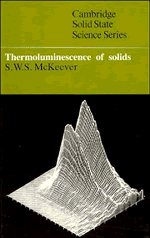Book contents
- Frontmatter
- Contents
- Preface
- 1 Introduction
- 2 Theoretical background
- 3 Thermoluminescence analysis
- 4 Additional factors governing thermoluminescence
- 5 Defects and thermoluminescence
- 6 Thermoluminescence dosimetry (TLD)
- 7 Thermoluminescence dating
- 8 Geological applications
- 9 Instrumentation
- Appendix A Minerals
- Appendix B Commercial thermoluminescence systems
- References
- Index
4 - Additional factors governing thermoluminescence
Published online by Cambridge University Press: 04 April 2011
- Frontmatter
- Contents
- Preface
- 1 Introduction
- 2 Theoretical background
- 3 Thermoluminescence analysis
- 4 Additional factors governing thermoluminescence
- 5 Defects and thermoluminescence
- 6 Thermoluminescence dosimetry (TLD)
- 7 Thermoluminescence dating
- 8 Geological applications
- 9 Instrumentation
- Appendix A Minerals
- Appendix B Commercial thermoluminescence systems
- References
- Index
Summary
In this chapter several other effects which are often observed in thermoluminescence experiments are discussed. Correct interpretation of these effects is important for a more complete understanding of the thermoluminescence data. To begin with some explanations of the phenomenon of supralinearity are examined as alternatives to the competing trap model detailed in the previous chapter.
Further discussions of supralinearity
Multi-stage reaction models
The supralinear growth curves described in figures 3.26 and 3.27 are characterized by a linear region, followed by a region of supralinear growth. In some cases, the opposite effect is seen in which the supralinear region precedes the linear part. Such behaviour is generally less common than that shown in these figures, but has been observed in several classes of material. An often-quoted example is the thermoluminescence from quartz extracts from pottery, for example figure 4.1 in which the low-dose supralinear region presents difficulties when using thermoluminescence as a method of age determination (see chapter 7). In general, supralinear growth can manifest itself in a growth curve in which the thermoluminescence intensity, I, increases as a function of Rl, where l is not necessarily one, nor is it necessarily an integer, and R is the absorbed dose.
- Type
- Chapter
- Information
- Thermoluminescence of Solids , pp. 127 - 152Publisher: Cambridge University PressPrint publication year: 1985
- 1
- Cited by



